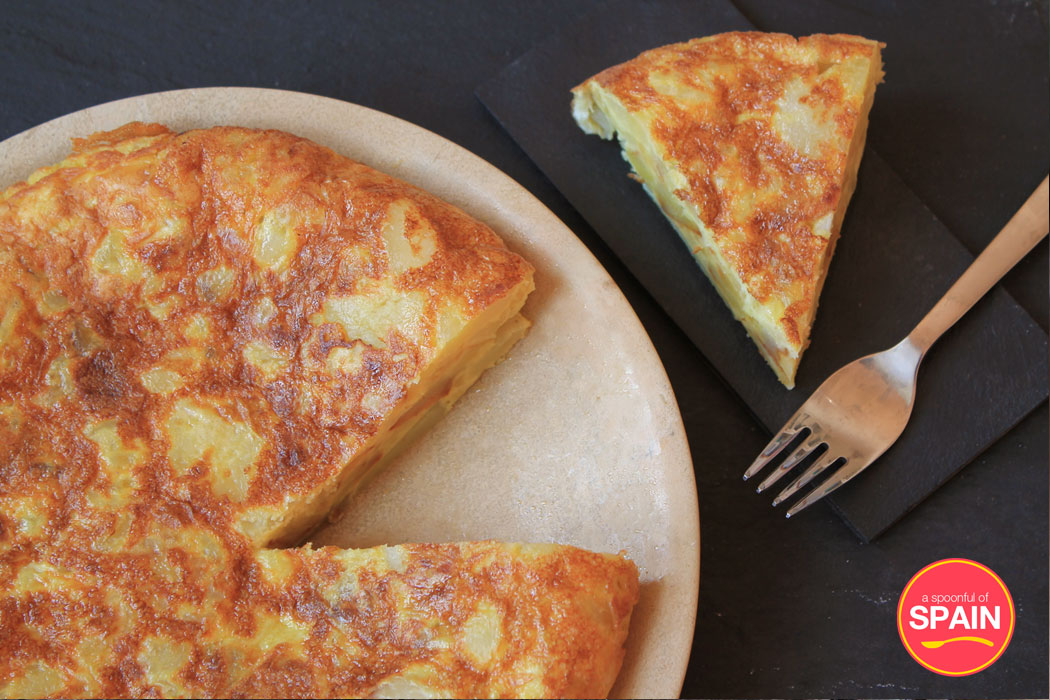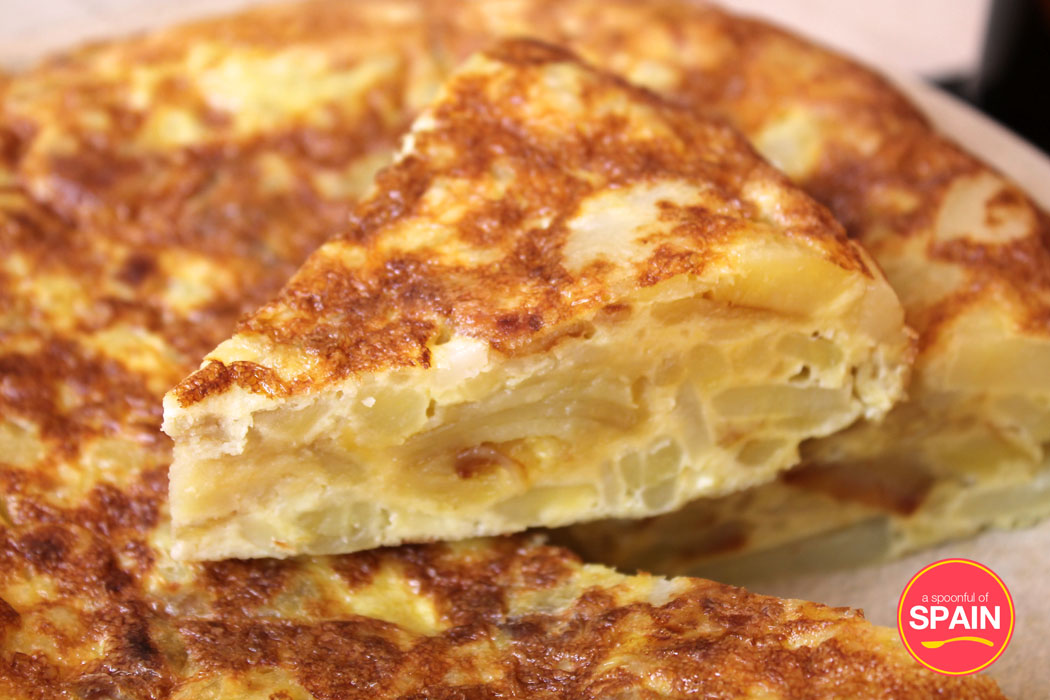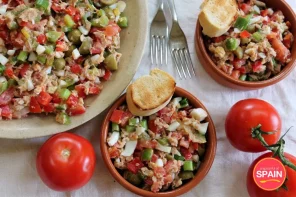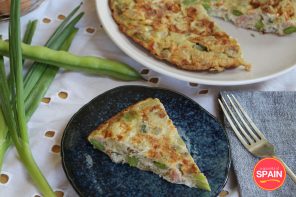Some would say that there’s nothing more Spanish than a Spanish omelette, or a tortilla de patatas. You can find Spanish omelette served all over Spain. In Madrid, they eat slices of tortilla with coffee for breakfast, and in other places, as a tapa, a ración for sharing, or as a light dinner.
As with so many classic dishes (see paella!), the recipe of Spanish omelette is fiercely contested. Our resident Spanish cook swears by the following Spanish omelette commandments:
- Add potato to egg, not egg to potato! This must also happen in a bowl, not in the saucepan!
- Flip, don’t grill! Grilling makes it a frittata, not a Spanish omelette.
- Onion is the only permitted extra ingredient. Adding things such as asparagus, prawns or mushrooms is totally valid, but it would no longer be considered a Spanish omelette.
- Last, but not least, no chorizo!
Don’t be scared by the amount of oil in this recipe – you need to use lots of oil so that the potatoes, and later the omelette, don’t stick to the saucepan. I would also strongly recommend using non-stick saucepans for this recipe – we’ve tried with normal saucepans, and it was a huge disaster! I would also like to highlight the importance of using quality ingredients, especially olive oil. Spanish omelette only has 4 ingredients, and so there is space for each flavour to sing. Although it may sound bland, fresh quality ingredients, prepared simply, are the key to classic delicious Spanish cuisine!
Ingredients (makes one large omelette – serves around 4):
6 large potatoes (around 1kg)
150ml olive oil (+3tbsp for the saucepan)
8 medium eggs
salt to taste
Instructions:
1. Peel the potatoes. Cut each potato into quarters, and then slice each quarter thinly. It’s important to work quickly, or your potatoes will oxidise and turn black!
2. Add 150ml olive oil to a wide, deep non-stick saucepan. Add the sliced potatoes and stir to coat evenly in oil. Cover the saucepan with a lid and cook on a medium heat for around 30 minutes. Season with salt to taste. Stir gently every five minutes to make sure that all the slices are cooked evenly. Remove from the heat when the potatoes are golden and cooked through, but not so soft that they crumble apart.
3. Break the eggs into a large bowl and mix thoroughly with a fork. (or alternatively, separate the whites from the yolks, and beat separately. When the egg white have become foamy, combine with the yolks and stir gently until evenly mixed. This will give your omelette amazing height, but it is not essential.)
4. Add the cooked potatoes to the egg mixture in the bowl and mix thoroughly.
5. Add the 3tsbp olive oil to a large wide non-stick saucepan. Make sure that oil covers the bottom of the saucepan and turn up the heat to medium. Pour the egg and potato mix into the saucepan. After a few minutes, run a spatula down the sides of the saucepan to make sure that it isn’t sticking, and cover with a lid.
6. After around 7 minutes, turn the omelette over. Move the saucepan from side to side to check that it is mostly set before attempting the flip! You can buy a special utensil that will help you to flip your omelette, but a flat lid or plate also works well. Take your omelette over to the sink, and cover the saucepan with a large plate or lid that is the same size or larger than the saucepan. Turn the saucepan over, leaving the tortilla cooked side up on the plate. Gently slide the tortilla cooked side down back into the saucepan, and return to the heat. Cook for a further 5 minutes.
7. Serve in slices as part of a main meal, or cut into squares for a tapa. If you are need of a carb fest – add slices of the omelette to french bread with ketchup for a bocadillo de tortilla de patatas!
Did you manage to flip your omelette successfully? Do you add anything else to your Spanish omelette? Let us know in the comments below!






Step 6, worth addressing if you have a long moment. The seven minutes might be enough if it is a wide pan but from the photos it seems it is narrow but deep. Of course, the wide pan would leave a thin tortilla that would be a nightmare to flip even with a large cutting board, not to mention the unappetising look it would have. My tortillas are twelve eggs (700g dozen free range) in a non-stick 28cm pan, similar amount of potatoes but one halved and finely sliced brown onion in with the potatoes as well. This was the way I was taught in the region Valenciana, the onions unravelled and were meant to act as a form of mesh that kept it all together making it easier to flip during cooking and cut for the customer (it had to be cut on request, no idea why). I was there for thirteen years so that could be a local thing, never found any tortillas in bars that did not have onion though. We also added a little (enough to provide aroma and not overburden the dish) oven roasted garlic paste to the egg mix, never raw garlic as there was a risk of it catching and burning with the resulting acrid consequences. The initial stage is the same for me, ensuring the edges cook but are checked that they are not catching or burning. Low heat all the way and once I am happy the edges are safe a lid goes on to conserve heat for the centre. Check the centre at fifteen minutes then get ready to flip if it’s strong enough to handle the move, ours were always made relatively solid but I make more runny ones at home, I like them. I do the same thing with a large plate but I also smear oil from my spatula on the dry plate to make release a lot smoother and to avoid and breaks. This is where your instructions would be confusing to a novice cook though: “Turn the saucepan over, leaving the tortilla cooked side up on the plate. Gently slide the tortilla cooked side down back into the saucepan, and return to the heat.” So it has been flipped to reveal the cooked side but you then ask for the cooked side to be down when returning it to the pan. Todo al rebes, it should be the uncooked side down to finish the process. The edges need to be tended again to form a more rounded profile, probably not needed at home but it is for commercial presentation in a better establishment. Sorry to waffle on like I have, tortilla de patatas is a very simple thing but can be truly amazing when made correctly and served properly. I have come across some comical efforts in my time but your photo shows you know what you are doing. On an unrelated note I would question the use of saffron in the albondigas but that’s your version and I have no doubt it’s delicious. Buen provecho!